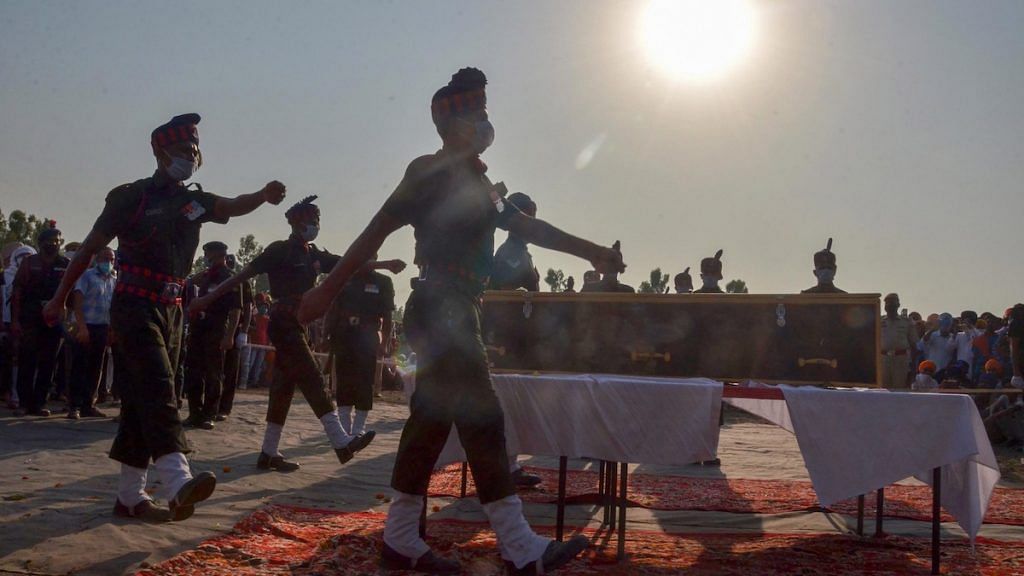Home they brought her warrior dead” — goes the opening lines of Alfred Tennyson’s famous poem. Unfortunately, it is now being repeated in at least 20 homes in India, and in the hearts of crores of Indians. While the immediate family and friends of those who died at the Line of Actual Control in the stand-off with China grieve with a pain that only they can feel, the rest of us wonder how this has come to pass.
Are we a country of perpetual sleepers? We were found sleeping in the 1950s when our northern neighbour went about building a strategic highway in Aksai Chin. Then it happened again in 1999 at Kargil, and now when the Chinese hoodwinked us and have come prepared with a plan in Galwan, Pangong Tso in Ladakh and Naku La in Sikkim.
Also read: Doklam team of Jaishankar-Doval-Rawat let Modi down but he has an option
Intelligence failure
We have been napping despite the creation of the Defence Intelligence Agency and the National Technical Research Organisation (NTRO) – both charged with collecting intelligence. The NTRO has no dearth of funds and operates its own unmanned aerial vehicles (UAVs). Then there is the Research and Analysis Wing (R&AW), with its operatives and links abroad; there are the intelligence wings of the Indo-Tibetan Border Police (ITBP), the Sashastra Seema Bal (SSB), and others — pray, what have they all been doing as the Chinese planned this operation?
The Cabinet Secretariat has specialised aircraft as part of its Aviation Research Centre with a task just to avoid a Galwan-like situation. And if they indeed did their job and had raised the red flag, who in the hierarchy didn’t follow up?
After Kargil happened, the Director of Air Operations of the Pakistan Air Force, Air Commodore Kaiser Tufail, wrote that when he visited Skardu in Gilgit-Baltistan, he saw hectic activity – intense helicopter flying, messes abuzz with war-is-coming murmur –and was sure that Indian intelligence would have picked it up. We were none the wiser and got a rude shock when Capt. Saurabh Kalia’s mutilated body was returned even as we were stirring into action.
Now, the injuries to Indian soldiers have been replicated at Galwan, in a most brutal manner. Defence Secretary Ajay Kumar tweeted: “A zillion salutes to the brave hearts…(sic)”. Defence Minister Rajnath Singh tweeted his condolences, and Prime Minister Narendra Modi said that they “..died fighting… maarte maarte mare” and observed a two-minute silence with all the chief ministers in their honour.
Tennyson came back to mind, for he had followed up his “Home they brought her warrior dead…” verse with “Then they praised him, soft and low; called him worthy to be loved; truest friend and noblest foe…”. This was 1847 being repeated in 2020. Have we changed?
Also read: Chinese have changed the rules of engagement at LAC. It’s time India did too
Getting down to real work
When will we change from our habit of just appreciating and going gaga over the words of our brave soldiers who said, “Yeh dil maange more” and climbed the hills of Kargil, never to return? Perhaps, a similar quote will form the narrative of Galwan when the full story of 16 Bihar regiment is written, and we will go to town with it in another round of symposia and seminars presided over by people in power – amidst much cutting of ribbons and garlanding of photo frames. But when will we get down to work — real work?
When will the head of capital acquisitions in the Ministry of Defence, and our political executive, understand that deterrence is derived from hard power, which our armed forces project, and not from ‘zillion salutes’ that are offered after an armed engagement? When will the Secretary of Defence Production accept that his/her department is in charge of, and responsible for, defence manufacturing output of not just government Defence Public Sector Undertakings (DPSUs) but private ones too, and work towards capability and capacity accretion?
Can we have a Union minister looking after defence production only? Can the ponderous Defence Research and Development Organisation (DRDO) be stirred into action to give us cutting-edge technology? If we had that kind of power, our adversary China would not have launched the adventure that it has embarked on. And the power deferential shows in the way we reacted to Kargil and the way we are responding now.
Also read: Modi govt and military leaders have soldiers’ blood on hands. PM’s dilemma now same as Nehru
No petty politics
Power flows through the barrel of a gun, said Mao, but a gun is not built in a day. It’s time that a long-term view of our capabilities and capacities is taken; the Chinese have a 100-year time-span to return to their claimed glory, as they see it.
At present, let the head rule the heart, our (rightly) inflamed passions notwithstanding. National security has to override political expediency, for only then will a bi-partisan approach emerge. Let us not have the spectacle of the photos of our 20 braves adorning election posters and platforms, a la the CRPF soldiers who died in Pulwama; let them not be used for petty political gains. The opposition of the day (tomorrow it may be another party) must be part of the process so that there is a strategic continuum, like in the nuclear and space sector.
The soldiers who died in Galwan, and the many who were grievously injured, belong to us all; they fought to protect the name of their paltan (regiment) and the nation in the highest tradition of the Indian Army. To paraphrase Tennyson — let this part be penned when we have paid our dues to our braves guarding us on those dangerous frontiers. For now, let us all, together, look the adversary in the eye.
The author is Addl Director General, Centre for Air Power Studies, Delhi. Views are personal.
